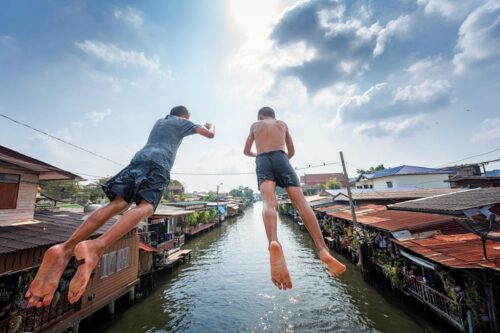Bangkok attractions: Khlong Bang Luang (Khlong Bangkok Yai), Phra Racha Wang Derm (Thon Buri Palace) and Wichai Prasit Fort, Wat Hong Rattanaram Ratcha Woravihara, Wat Ratcha Orasaram Ratchawora Vihara, Kudi Charoen Phat, Tonson Mosque, Khun Luang Rit Narongron Museum, Wat Sai Area Wat Nang Rajaworawihan Wat Nang Nong Woravihara.
Table of Contents
Khlong Bang Luang (Khlong Bangkok Yai)
 Photo credit: sarakadee.com
Photo credit: sarakadee.com
It was an old community since the Ayutthaya period. Khlong Bang Luang was a part of Chao Phraya River until there was canal dredging in the Ayutthaya period between 1534-1546. It became a canal the same as Khlong Bangkok Noi and Khlong Chak Phra.
 Photo credit: bkknowconnect .com
Photo credit: bkknowconnect .com
The other name of Khlong Bangkok Yai is Khlong Bang Luang that comes from the nobleman who moved to live near Khlong Bangkok Yai that is near the Thon Buri, the new capital in Somdet Phra Chao Taksin period. Villagers called it Khlong Bang Ka Luang and shorten the name to Khlong Bang Luang and we can see the ways of old life such as one–floor homes and old temples in this area.
Phra Racha Wang Derm (Thon Buri Palace) and Wichai Prasit Fort
 Photo credit: ข่าวสด
Photo credit: ข่าวสด
The fort was built before the palace. It was formerly named Wichayen after Chao Phraya Wichayen (Constantine Phaulkon), the Greek who closely served King Narai of Ayutthaya. Phraya Wichayen was the one who begged the King to build the fort as a defensive measure against Hollanda marine force.
When King Taksin ascended the throne, he built the palace near the fort, and renamed it as ‘Wicahi Prasit Fort’, where he later was executed. The palace became the residence for many generations of Chakri dynasty royal family. In King Rama V’s period, the palace became Royal Thai Naval Academy.

In 1955, Royal Thai Navy renovated the palace to be the Royal Thai Navy Headquarters, the graceful building which was recognized by the UNESCO Asia-Pacific Awards for Cultural Heritage Conservation in 2004. Location : In the area of Royal Thai Navy ueodeugrtore Arun Ammarin Rd..
Wat Hong Rattanaram Ratcha Woravihara
 Photo credit: manager.co.th
Photo credit: manager.co.th
 Photo credit: Supawan K.
Photo credit: Supawan K.
Wat Hong Rattanaram was named after the Chinese wealthy man who built it. Thus, it was known in the past as ‘Wat Chao Khrua Hong’ in King Taksin’s period. The temple was very important because it was located near the palace, which the King had restored thoroughly. There is a holy water pond inside Wat Hong Rattanaram with its legend that every time before going to war, King Taksin would bath himself in this pond.
 Photo credit: bloggang.com
Photo credit: bloggang.com
The bathing ritual still goes on today. In King Rama IV’s period, Phra Saen was brought from Chiang Taeng in 1858 because the King had learnt about the legend of this beautiful Buddha, and the neighborhood was full of Lao people. According to the historical resource, Phra Saen was built by Phra Kru Pon Samek, one of the important monks in the history of Lan Chang, with more than 192 kilograms of copper and brass.

Furthermore, Wat Hong Rattanaram also housed Sukhothai style golden Buddha, which King Taksin had brought from the old capital. The Buddha’s appearance is similar to the golden Buddha of Wat Trimitr. Location: Soi Kudi Charoen Phat.
Kudi Charoen Phat (Charoen Phat Mosque)
 Photo credit: วิกิพีเดีย
Photo credit: วิกิพีเดีย
Built in the reign of King Rama I by the second Phraya Chula Ratchamontri of Rattanakosin (Agayi), Kudi Charoen Phat was named after the Saphan Charoenphat 33. The architectural design of the mosque is in the Manila style with a beautiful decoration of openwork carved wood which is a defining feature of the gingerbread house style.

 Photo credit: oknation.nationtv
Photo credit: oknation.nationtv
Kudi Charoen Phat is an important religious place of Chao Sen Sect, particularly the holding of ‘Chao Sen ritual’ to express Shia (Shiite) Muslims identity and faith in the Prophet Muhammad. Location : Itsaraphap Rd.
Tonson Mosque

Tonson mosque is the oldest mosque in Bangkok which was built since the Ayutthaya period. Tonson Mosque was formerly known as ‘Kudi Yai’ or ‘Kudi Bangkok Yai’ because of its location near the mouth of Khlong Bangkok Yai.
 Photo credit: true id .net
Photo credit: true id .net

In the reign of King Rama II, Tonson Mosque was restored to a concrete masonry building and the pediment decorated with Thai lacquer work. The dome of Tonson Mosque is in Egyptian style in the year eight hundred of the Hegira calendar and inside there is the ancient board of Arabic calligraphy. Location : Itsaraphap Rd., close to the Khlong Bangkok Yai.
Khun Luang Rit Narongron Museum
 Photo credit: thailandmuseum.org
Photo credit: thailandmuseum.org
The museum is situated on the Rit Narongron School Premises. It was originally the house of Khun Luang Rit Narongron (Jek Saengmanee). The museum building was built in 1923 during the reign of King Rama VI.

The museum is a two story structure that’s half Thai and half European architecture, embellished with decorative motifs of a combination of eastern and western artistic styles. The prominent feature of the building is a teak winder staircase wit a centre pole. Location: Soi Uwittaya, Phet Kasem Rd. soi 4. Open Mon-Fri. 08.30 am-16.30 pm
Wat Sai Area
 Photo credit: mgronline.com
Photo credit: mgronline.com
It is a big, populated and old community, located near the Khlong Sanam Chai which links with many other canals: Khlong Dao Kanong, Khlong Bang Khun Thian, Khlong Lad Ched Na, Khlong Bang Mod, and Khlong Dan which leads to the Chao Phraya River.

Wat Sai is the old community centre, built in the Ayutthaya era. This temple is more than three hundred years old. There are many styles of Buddha ages which are made of carved red sandstones. There is ‘Golden Palace’ which is a delicate Thai art, gilded both inside and outside. Phra Chao Seu dedicated this pala as a monks’ residence. It serves as a memorial for his journey through Khlong Sanam Chai.
 Photo credit: mgronline.com
Photo credit: mgronline.com
Besides, there are the old drum tower, ancient bell tower, and two-era temple. Behind Wat Sai is Mahachai-Wongwian Yai Train Station. There used to be a floating market in the Wat Sai Area. Many people say that it was the most beautiful water market. Farmers would put their fruits and local products in their boat to sell in this market. Later the business slowed down.
Ten years ago the Bangkok Metropolitan Administration tried to renovate it before it became slow again. Nowadays there is only one shop in a house which constantly receives many tourists. It helps to vitalize the place. Location: Soi Wat Sai or Ekkachai Rd. Soi 23
The 3 temples of King Rama IIl
Wat Ratcha Orasaram Ratchawora Vihara

 Photo credit: dhamma.org
Photo credit: dhamma.org
Wat Ratcha Orasaram Ratchawora Vihara is an old temple before the Rattanakosin period, and it used to be called ‘Wat Jomthong’, a temple of King Rama IIl. It was built in the King’s favorite Chinese architectural style. Wat Ratcha Orasaram is the first temple to be decorated with porcelain. The walls are decorated with Chinese art and a Chinese altar table, which was the only one in Thailand. The plaster base of the Buddha image is very delicate and beautiful.

Wat Nang Nong Woravihara

King Rama Ill renovated “Wat Nang Nong Woravihara”, as you can see his favorite art in the temple and the twin viharas. The distinctive point is its hainess on the double roofs and the roof tiles.
Wat Nang Rajaworawihan



“Wat Nang Rajaworawihan” is an old temple which was appointed as a royal temple when King Rama III ascended the throne. Apart from the beautiful architecture, in the temple there is the “Wat Nang Ratchawora Vihara Education Museum”. Originally built to house the temple’s valuables it was later used to hold agricultural tools that people in the community donated to the temple. It showcases the traditional way of life of the local people which was rooted in agriculture.
Explorenique is also featured on momondo’s Bangkok Guide, one of the leading European online travel agents for price comparison.
Explorenique is also featured on “6 Top-Rated Bus Tours In Bangkok” by CLEVERTHAI. 

